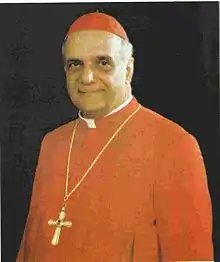Raphael I Bidawid
Mar Raphael I Bidawid † (Syriac: ܪܘܦܐܝܠ ܩܕܡܝܐ ܒܝܬ ܕܘܝܕ, Arabic مار روفائيل الاول بيداويد) (April 17, 1922 – July 7, 2003) was the Patriarch of the Chaldean Catholic Church from 1989–2003. He was also a Syriac scholar.
Raphael I Bidawid | |
|---|---|
| Patriarch of Babylon of the Chaldeans | |
 | |
| Church | Chaldean Catholic Church |
| Archdiocese | Babylon |
| See | Babylon |
| Installed | May 21, 1989 |
| Term ended | July 7, 2003 |
| Predecessor | Paul II Cheikho |
| Successor | Emmanuel III Delly |
| Orders | |
| Ordination | October 22, 1944 |
| Consecration | October 6, 1957 by Yousef VII Ghanima |
| Personal details | |
| Birth name | Raphael J. Bidawid |
| Born | April 17, 1922 Mosul, Iraq |
| Died | July 7, 2003 (aged 81) Beirut, Lebanon |
| Residence | Iraq |
Life
He was born on April 17, 1922 in the northern Iraqi city of Mosul into an ethnic Assyrian[1] family, and took his school and seminar training in Mosul. He was ordained a priest on October 22, 1944 in Rome and in 1946 he obtained the academic degrees of doctor of philosophy and theology. Between 1948 and 1956 he worked as a professor of philosophy and theology in Mosul. On October 6, 1957, at the age of 35, he was ordained Bishop of Amadiya, by Patriarch Yousef VII Ghanima,[2] becoming the youngest Catholic bishop in the world.[3] As bishop of Amadiya he experienced the mass exodus of Christians from Northern Iraq. Mar Raphael Bidawid was then appointed bishop of Beirut in 1966 and served in this capacity for 23 years.
On March 21, 1989 Raphael I Bidawid was elected Patriarch of Babylon, head of the Chaldean Catholic Church. His election was confirmed by Pope John Paul II in June 1989. During his patriarchate, in agreement with the Chaldean Synod, he established The Pontifical Babel College for Philosophy and Theology in 1991. The Babel College is situated in Baghdad, Dora, El-Mekaniek, next to St. Peter Chaldean Seminary. The Babel College became an instrumental educational institution for the Chaldean Church.[4][5] Patriarch Bidawid could speak 13 languages. He died in Beirut, Lebanon on July 7, 2003, at the age of 81.
Pastoral Work
Patriarch Bidawid was known as a champion of the unification of the Assyrian Church of the East (formerly the Church of the East) and the Chaldean Catholic Church, which split in 1552 AD. In November 1996 Mar Dinkha IV of the Assyrian Church of the East and Chaldean Patriarch Raphael I Bidawid met in Southfield, Michigan, and signed a Joint Patriarchal Statement that committed their two churches to working towards reintegration and pledged cooperation on pastoral questions such as the drafting of a common catechism, the setting up of a common seminary in the Chicago-Detroit area, the preservation of the Aramaic language, and other common pastoral programs between parishes and dioceses around the world.
On August 15, 1997, the two Patriarchs met again, in Roselle, Illinois, and ratified a “Joint Synodal Decree for Promoting Unity,” that had been signed by the members of both Holy Synods. It restated the areas of pastoral cooperation envisaged in the Joint Patriarchal Statement, recognized that Assyrians and Chaldeans should come to accept each other's diverse practices as legitimate, formally implemented the establishment of an Assyrian-Chaldean “Joint Commission for Unity,” and declared that each side recognized the apostolic succession, sacraments and Christian witness of the other. The text also spelled out the central concerns of both sides in the dialogue. While both churches wanted to preserve the Aramaic language and culture, the Assyrians were intent on retaining their freedom and self-governance, and the Chaldeans affirmed the necessity of maintaining full communion with Rome.[6]
In an interview with Bidawid, published in 2003, he commented on the Assyrian name dispute and declared his ethnic point of view:
- “I personally think that these different names serve to add confusion. The original name of our Church was the ‘Church of the East’ ... When a portion of the Church of the East became Catholic, the name given was ‘Chaldean’ based on the Magi kings who came from the land of the Chaldean, to Bethlehem. The name ‘Chaldean’ does not represent an ethnicity... We have to separate what is ethnicity and what is religion... I myself, my sect is Chaldean, but ethnically, I am Assyrian.”[7]
In an interview with the Assyrian Star in the September–October 1974 issue, he was quoted as saying:
- “Before I became a priest I was an Assyrian, before I became a bishop I was an Assyrian, I am an Assyrian today, tomorrow, forever, and I am proud of it.”[8]
Bibliography
- Raphael J. Bidawid, Les lettres du patriarche nestorien Timothee I, Studi e Testi 187, Vatican City (1956)
Notes
- Assyrians Mourn the Passing of Patriarch Raphael
- "Archbishop Raphaël I Bidawid". Catholic-Hierarchy.org. Retrieved 2009-05-30.
- http://www.britannica.com/biography/Raphael-I-Bidawid
- Chaldean Patriarchate of Babylon Pontifical Babel College For Philosophy and Theology "Archived copy". Archived from the original on 2011-07-16. Retrieved 2010-06-06.CS1 maint: archived copy as title (link)
- Kiraz, George A. "Mar Raphael Bidawid (1922-2003)". Hugoye: Journal of Syriac Studies. Archived from the original on 2008-12-22. Retrieved 2009-05-30.
- CNEWA page on The Assyrian Church of the East. http://www.cnewa.org/default.aspx?ID=1&pagetypeID=9&sitecode=HQ&pageno=3
- Parpola, Simo (2004). "National and Ethnic Identity in the Neo-Assyrian Empire and Assyrian Identity in Post-Empire Times" (PDF). Journal of Assyrian Academic Studies. JAAS. 18 (2): 22. Archived from the original (PDF) on 2011-07-17.
- Mar Raphael J Bidawid. The Assyrian Star. September–October, 1974:5.
External links
| Religious titles | ||
|---|---|---|
| Preceded by Paul II Cheikho (1958–1989) |
Patriarch of Babylon of the Chaldean Catholic Church 1989–2003 |
Succeeded by Emmanuel III Delly (2003–2012) |